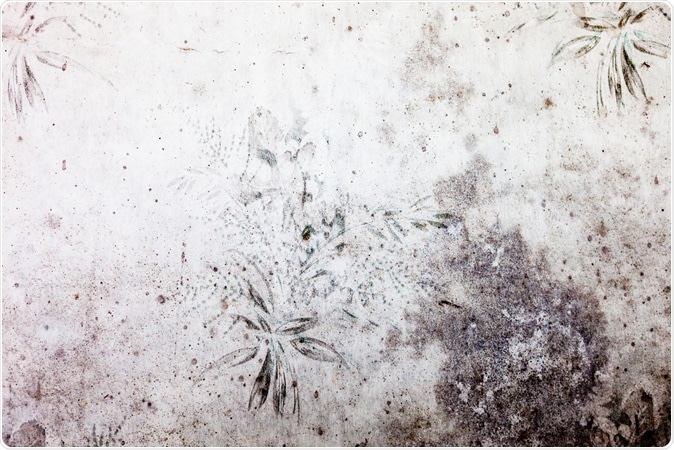According to a new study, there are several toxins from fungi that could be released into the air indoors and the source could be fungi living in the wall papers. These may lead to serious health problems say researchers.

Fungal toxins from wallpaper source of illness says new research. Old dingy and dirty wallpaper with floral pattern. Image Credit: rootstock / Shutterstock
These ordinary fungi that live with the household wallpaper are basically of three types found the study researchers. They can grow and eventually spread to the air. This leads to serious health consequences. These effects of transmission of the airborne fungi and their toxins on human health have not been studied or considered with importance till date say researchers.
The toxins released from the fungi are called mycotoxins. They can pollute the indoor air and lead to indoor air pollution – a condition called sick building syndrome. Sick building syndrome is a condition where the residents start to feel ill according to the time they have spent in a building. The illness is usually not pinpointed at any instance according to the U.S. National Institutes of Health.
Study co-author Jean-Denis Bailly, a professor of food hygiene at the National Veterinary School of Toulouse in France in a statement explained that these mycotoxins are released from moldy material of growth of the fungi. They are eventually inhaled by the inhabitants of the home. While investigating the quality of air indoors especially at homes that have higher fungal contamination, the indoor air quality also needs to be tested for fungal toxins, he explained.
The results of the study were published last Friday in the American Society for Microbiology’s journal Applied and Environmental Microbiology.
According to researchers, there has been extensive study of fungal contamination of food. However there has been little work in terms of fungal toxins in air. For this study they looked at three fungi that commonly also contaminated foods - Penicillium brevicompactum, Aspergillus versicolor and Stachybotrys chartarum. A piece of wallpaper was found to be contaminated with these three fungi. A flowing stream of air was allowed over the wallpaper and samples of air of the room were then collected for testing.
On analysis of the indoor air the researchers found that the small particles of dust floating around in the house which could then be inhaled easily, contained toxins from these fungi. Also all fungi did not spread the toxins at the same rates they found. Some spread more toxins than others and this could help researchers to decide on which fungi species to concentrate on in terms of disease prevention they said.
The study reports that in Northern Europe and North America as many as 20 to 40% buildings show fungal growth that is visible to the naked eye. Aspergillus versicolor, a potent producer of sterigmatocystin (STG), has been found in dust, air and building material samples wrote the researchers.
Air pollution has focused on chemical emissions more than these toxins said researchers. Car and factory emissions, emissions from chemical fumes and smoke have been studied in details for their capacity to harm humans. Effect of household mold on air pollution and its impact on humans has been a blind spot till now. According to Bailly efforts of energy efficiency has meant that more houses are insulated to save on heating and cooling. This in turn allows fungi to grow especially in the moist areas, such as in bathrooms or kitchens. Appliances that are wet also tend to draw in moldy growth. With this study, he explained, indoor air quality testers would have another parameter to consider – presence of fungal mycotoxins.